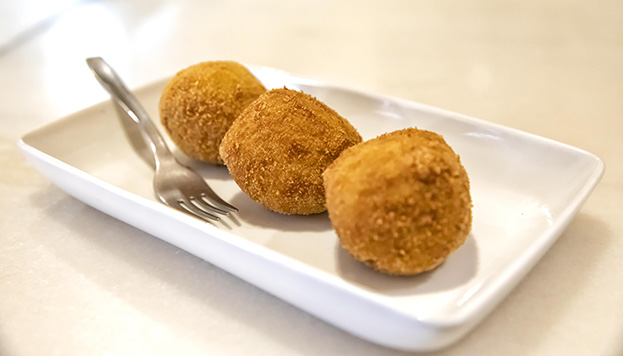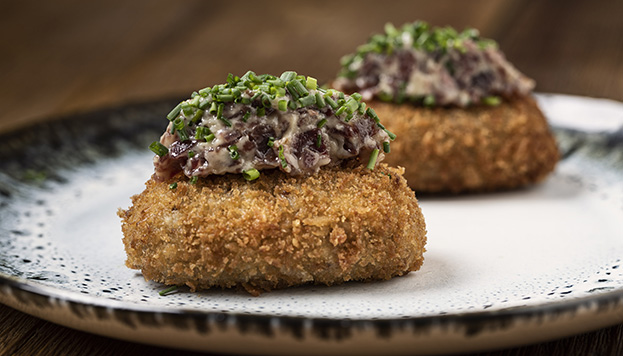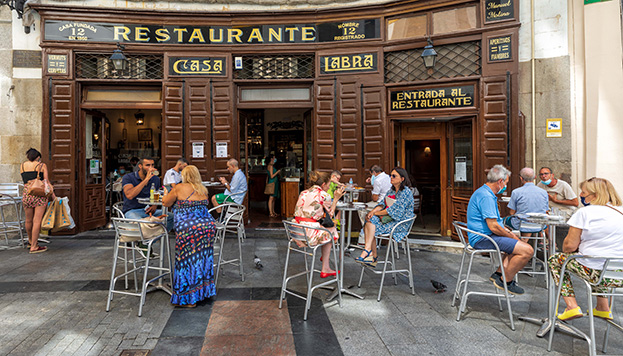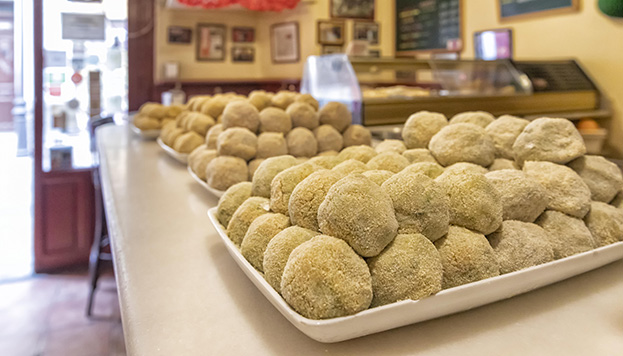
Casa Julio. © Álvaro López del Cerro.
It’s a sentence you’re bound to hear in Madrid’s tabernas and bars. Croquetas are a bite-sized delicacy, steeped in centuries of tradition. Read on to discover our mouth-watering route.

Sagrario Tradición
Order by the unit as an appetiser or as a ración (bigger portion) to share. It’s impossible to find a bar in Madrid that doesn’t serve these bite-sized fritters—an essential part of our city’s emotional gastronomy. A croqueta (or croquette) is a small amount of dough with minced ingredients, bound together with béchamel sauce, dipped in egg, coated in breadcrumbs and then fried in a generous amount of oil. You’ll come across them both round and oval in shape, depending on who makes them. We’re crazy about them here, although, interestingly enough, they are originally from France: croquette means crunchy. The indispensable béchamel sauce was invented, or at least perfected, by Louis de Béchameil, who went on to become the head chef for King Louis XIV of France. The first recorded mention of this delicacy was slightly earlier, in 1817, when Parisian chef Antonin Carême apparently made croquettes for a banquet served in honour of the Prince Regent of England and Grand Duke Nicholas Nikolaevich of Russia. In the words of Ramón Gómez de la Serna “croquettes should have a bone in them, at least this way we’d be able to keep count of how many we’ve eaten.” But we’re not interested in number crunching, we’re here to indulge. So let’s give in to temptation on this tour.
A centuries-old classic

Casa Labra. © Álvaro López del Cerro.
Accompanied by a well-poured caña (small glass) of beer, or perhaps a glass of wine from the Valdepeñas region, the croquettes at Casa Labra (Calle de Tetuán, 12) are some of the most famous in Madrid. Located within walking distance of Puerta del Sol, this bustling taberna first opened its doors in 1860 as a small wine cellar. Today it still bears the name of its founder, an Asturian businessman who set up shop on this main street alongside several bars. Back then the joint had little more than a bar with a zinc countertop. At the turn of the century at its helm was the Baldomera family, who gave the bar its first big makeover. To this day you’ll still find some of these original elements, including furniture, mirrors, a clock and a rather lustrous chandelier, which surely would have impressed its customers.

Casa Labra
The former local ordinances obliged those who served food made using oil to wear white as a symbol of cleanliness—a tradition that still lives on to this day. It was in 1947 that the establishment passed into the hands of the Molina family, the current owners of the bar. However, Casa Labra is much more than just its past. If the doors of its wooden concave façade have remained open all these years, the food must have something to do with it. Specifically the freshly fried cod slices and cod croquettes, which are simply to die for. You’re not a true local until you’ve tried them. The good news is that they make more than one thousand a day!
The new kids on the block

Casa Mories. © Álvaro López del Cerro.
Close by, next to Plaza Mayor, is Casa Mories (Plaza de San Miguel, 5). Opened just a few months ago, it follows in the footsteps of some of the most-loved bistros in the capital that serve only homemade dishes. In the kitchen is chef Beltrán Alonso, who brings a modern twist to this traditional fare, with his delicious croquettes being one of the tastiest examples of this ethos. Order them stuffed with carabinero prawns for a spectacular, creamy experience, or with cured beef from the León region—also a speciality at Ferretería (Calle de Atocha, 57). This restaurant is located in what once was—as its name in Spanish suggests—a hardware shop dating back to 1888.

Casa Mories. © Álvaro López del Cerro.
“Our menu is based on local, traditional cuisine, with flavours that take us straight back to our childhood and dishes that encourage us to use spoons and eat with our hands, to butter a slice of bread and enjoy the food as if we were in our own home.” These are the words of the managers at Casa Mortero (Calle de Zorrilla, 9), who are bent on bringing back the flavours of yesteryear with dishes such as Madrid-style tripe and their divine, crispy Iberian ham croquettes.

Casa Julio. © Álvaro López del Cerro.
At Casa Orellana (Calle de Orellana, 6) they make their croquettes stuffed with ox tail, and at Media Ración (Calle de la Beneficencia, 15) with cured ham and porcini mushrooms. Boiled egg and gammon steak is the filling of choice at La Bien Aparecida (Calle de Jorge Juan, 8), and you’ll find flavours such as wild mushrooms and leek, minced meat, spinach, raisins and gorgonzola, and also morcilla blood sausage and quince at Casa Julio (Calle de la Madera, 37). The latter, a taberna with a red façade in the Malasaña district, is definitely worth a visit. Founded in 1921, it rose to fame around the world when the Irish group U2 chose it as the location for a publicity photo shoot over twenty years ago. It’s a shame Bono and the gang didn’t get a chance to try this house speciality, which has a group of loyal fans who drop by every weekend without fail to get their croquette fix. We could almost say that the croquettes here are somewhat legendary in the city, a title which the croquettes at Sagrario Tradición (Plaza de Valparaíso, 3)—filled with grilled skirt steak and cured beef ali oli—are also worthy of.
The best in the world

Miguel, Carretero, Santerra. © Álvaro López del Cerro.
A flavour rich in ham and delicately creamy. And a lightly breaded yet perfectly crunchy texture that melts in the mouth. It’s for these reasons that Miguel Carretero, the chef at Santerra (Calle del General Pardiñas, 56), took home the prize for the best croquette in the world at the latest edition of the Madrid Fusión Alimentos de España gastronomy summit held in March. You can order them at Santerra’s La Barra or downstairs in the restaurant. They also serve them at Neotaberna Santerra (Calle Ponzano, 62), which makes for the perfect place to try a selection of tapas or tapear, as the locals would say. We simply love culinary delights that combine classic recipes steeped in the customs of the capital, with hints of foreign cuisine that take diners on a journey of flavours, without ever leaving the city. And we’re in luck! Here we have the recipe for the “champion of champions” (although we strongly recommend trying them at the restaurant itself). They’re simply divine!
RECIPE
Miguel Carretero, Santerra

Ingredients:
2.4 litres of double cream (cow’s milk)
250 grams of butter
250 grams of plain flour
0.3 litres of cream (33% fat)
10 sheets of gelatine
350 grams of thinly sliced Joselito cured Iberian ham
1 cured Iberian ham bone
Flour
Egg
Panko
 Method:
Method:
Melt the butter and add the flour in two batches. Cook on a low heat until the flour is completed cooked. Meanwhile, infuse the milk with the cured ham bone. Slowly pour the hot milk into the roux, stirring continuously on a low heat, until you get a smooth béchamel sauce. Add the diced ham, stir for one minute and add salt to taste.
In another saucepan, heat the cream and add the previously soaked and dissolved gelatine sheets. Strain the mixture and add the cream to the dough, stirring it as it cools down. Pour into a container and cover with cling film to store in the fridge overnight.
Form balls with the dough and dip them in flour, egg and panko. Fry the croquettes in a mild olive oil at 190°C. Leave to rest before serving.